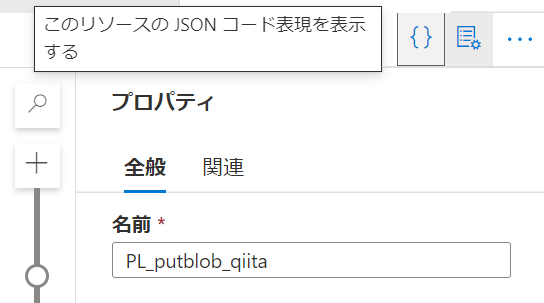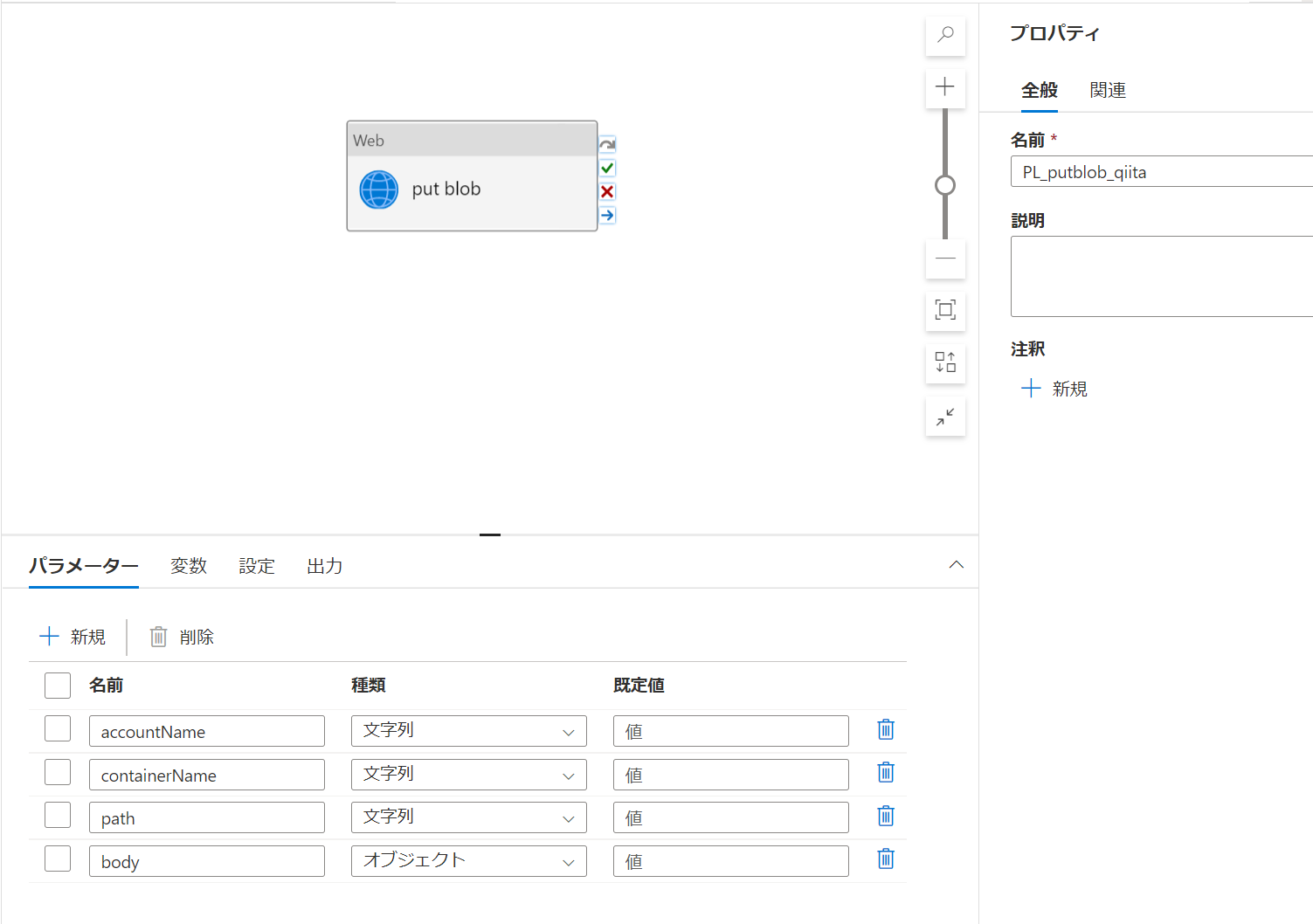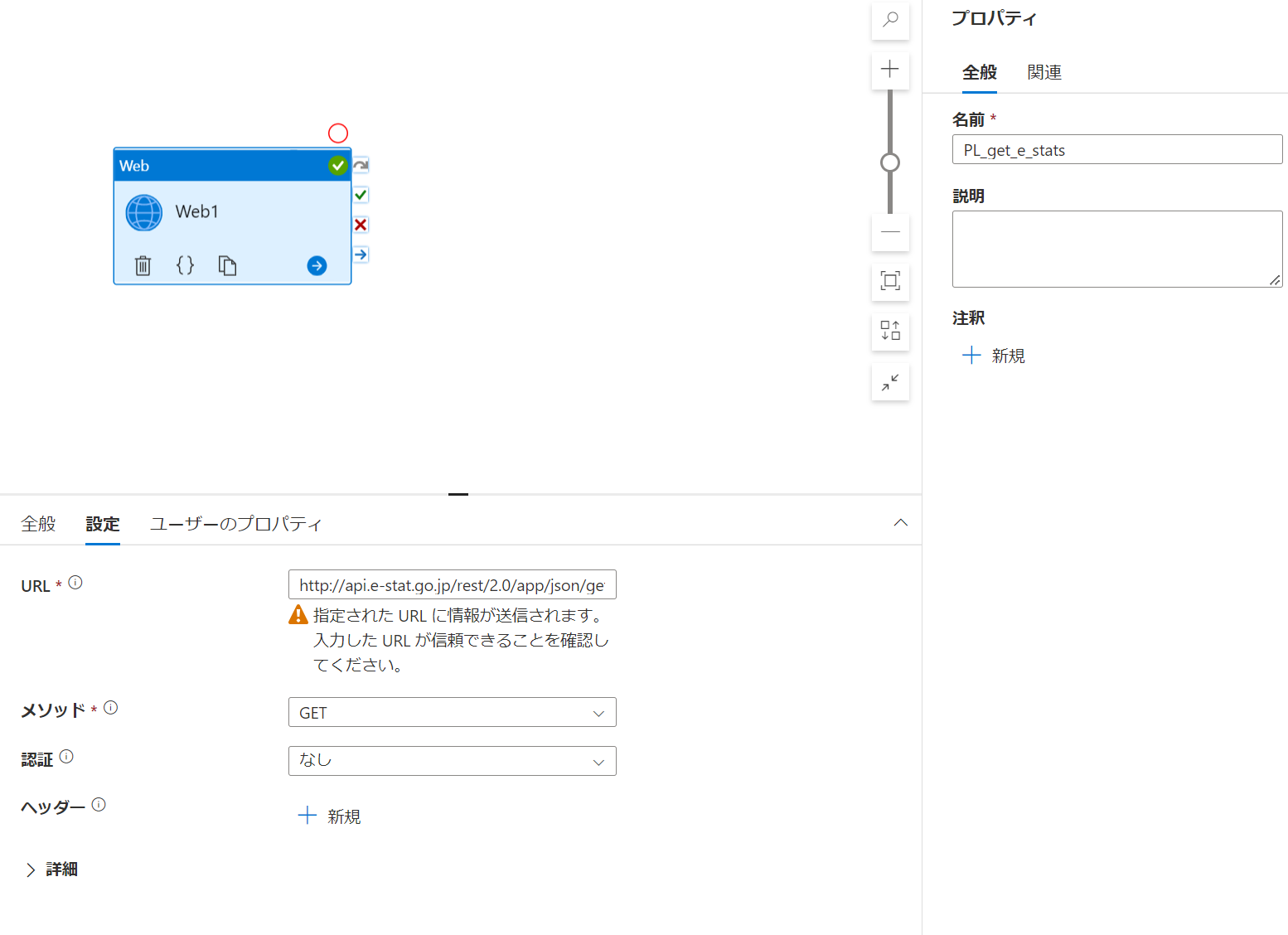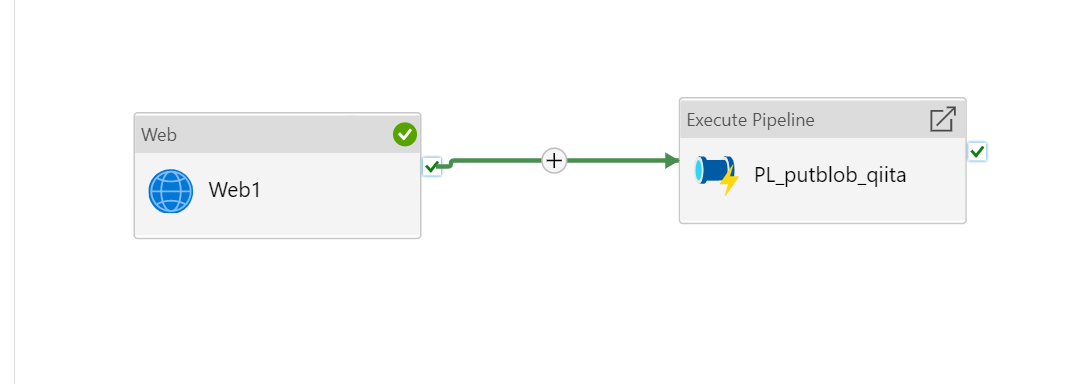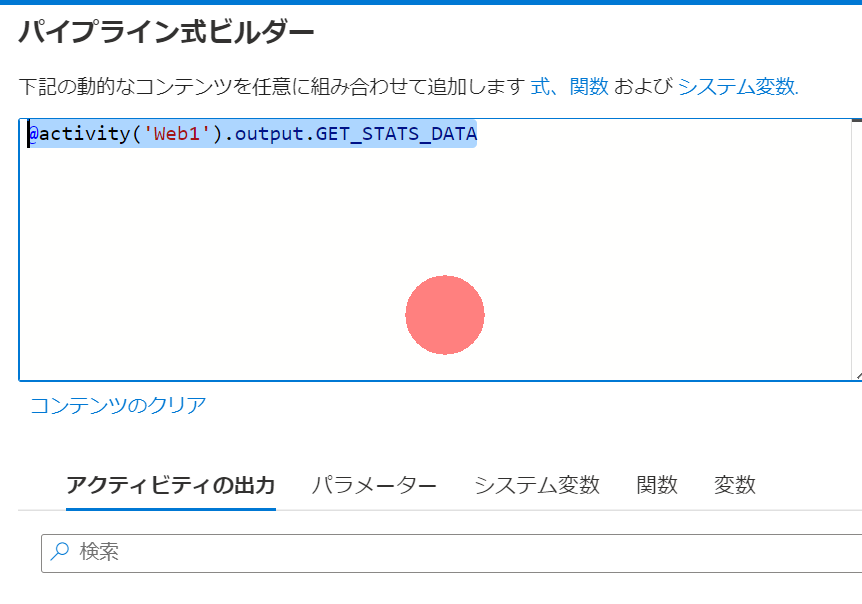はじめに
Azure Data lake Storage Gen2 には、Blob / Data Lake のREST APIの口があるので、pipelineからMSI認証でデータを書き込んでみる
モチベーション
copyアクティビィでRESTをソースに処理ができますが、たまにうまくパースされないレスポンスを返すサービスがあり、なんとかデータレイクに書き込む方法を探していました。
そこで以下の記事を見つけたのですが、認証方法に改善の余地があるので、MSI認証で通す方法を検討しました。
https://geekshangout.com/azure-data-factory-how-to-save-web-activity-to-blob-storage/
Put Blob ※Blob APIの利用
今回は、https://www.e-stat.go.jp/api/ からデータを取得してblobを書き込んでみようと思います。
参考:https://learn.microsoft.com/ja-jp/rest/api/storageservices/put-blob
準備
利用するのは、Synapse(マネージドVnet有効、データレイクにはファイアウォール設定あり)です。
まずは、e-statのサイトでAPI登録を行い、APP_IDを入手します。
1.会員登録後、マイページからAPI機能(アプリケーションID発行)をクリックします。
2.APPの情報を入力すると、APPIDが払い出されます。
3.https://www.e-stat.go.jp/api/api-dev/how_to_use のページでサンプルがあるので、こちらをそのまま使います。URLパラメータにAPPIDを入れれば簡単に取得できる仕組みです。
手順
1.PL_putblob_qiitaという名称で、パイプラインを作成します。{}ボタンから以下のコードを貼り付けます。
{
"name": "PL_putblob_qiita",
"properties": {
"activities": [
{
"name": "put blob",
"type": "WebActivity",
"dependsOn": [],
"policy": {
"timeout": "0.12:00:00",
"retry": 0,
"retryIntervalInSeconds": 30,
"secureOutput": false,
"secureInput": false
},
"userProperties": [],
"typeProperties": {
"url": {
"value": "https://@{pipeline().parameters.accountName}.blob.core.windows.net/@{pipeline().parameters.containerName}/@{pipeline().parameters.path}",
"type": "Expression"
},
"connectVia": {
"referenceName": "AutoResolveIntegrationRuntime",
"type": "IntegrationRuntimeReference"
},
"method": "PUT",
"headers": {
"x-ms-blob-type": "BlockBlob",
"x-ms-version": "2021-06-08"
},
"body": {
"value": "@pipeline().parameters.body",
"type": "Expression"
},
"authentication": {
"type": "MSI",
"resource": "https://storage.azure.com/"
}
}
}
],
"parameters": {
"accountName": {
"type": "string"
},
"containerName": {
"type": "string"
},
"path": {
"type": "string"
},
"body": {
"type": "object"
}
},
"annotations": []
}
}
貼り付けると今回作ったものが再現されます。
パラメータの内容は以下のようになっています。
- accountName: ストレージアカウント名
- containerName: コンテナの名前
- path: ファイルパス
- body: 書き込みたい内容
設定はこんな感じ
urlはパラメータからblobエンドポイント上のファイル名を作成するようになっています。
https://@{pipeline().parameters.accountName}.blob.core.windows.net/@{pipeline().parameters.containerName}/@{pipeline().parameters.path}
MSI認証でREST APIを実行するときは実行したい操作を管理しているリソースのエンドポイントのURLをリソースとして入力します。
今回はhttps://storage.azure.com/ でした。
2.次にe-statsからデータを取得するためのパイプラインを作成し、webアクティビティを配置します。
内容は先ほど確認したサンプルURLを入れています。
3.デバッグすると、出力結果からレスポンスの内容が確認できます。
GET_STATS_DATAという部分に結果が出ています。
4.先ほど作成したPL_putblob_qiitaを実行するように構成します。
5.パラメータのbodyを動的なコンテンツで構成します。
@activity('Web1').output.GET_STATS_DATA と入力してやります。
6.他のパラメータを入力してデバッグします。
7.成功するとblobが書き込まれます。
(供養) ※Data Lake APIの利用
こちらの方法はPipelineでは不適と判断しましたが、学びがあったのでメモだけ残します。
参考:
Data Lake APIでのファイルの書き込み方法は以下の3ステップで行います
1.ファイルの作成(create)
2.ファイルの書き込み(append)
3.ファイルの書き込みのコミット=フラッシュ(flush)
2で実際にデータを投入しますが、フラッシュしない限りファイルに反映されません。これが色々と厄介な仕様でした。
フラッシュ時には書き込んだバイト数を計算して、positionパラメータを指定しないと
{"error":{"code":"InvalidFlushPosition","message":"The uploaded data is not contiguous or the position query parameter value is not equal to the length of the file after appending the uploaded data.
のようなエラーが返ります。今回e-statsからcontents-lengthが取れたので使いましたが、数字は一致せず。。。動的にpositionをとることはpipeline上では難しいという判断にいたりました。
なお、2のappendと同時にフラッシュするっぽいパラメータflush=trueはうまく動作しませんでしたので、私のわかる範囲だとこの3ステップが必須です。
内容は以下に供養します。
パイプライン名をPL_create_file_qiitaにして以下のコードを貼り付けて下さい
{
"name": "PL_create_file_qiita",
"properties": {
"activities": [
{
"name": "create path",
"type": "WebActivity",
"dependsOn": [],
"policy": {
"timeout": "0.12:00:00",
"retry": 0,
"retryIntervalInSeconds": 30,
"secureOutput": false,
"secureInput": false
},
"userProperties": [],
"typeProperties": {
"url": {
"value": "https://@{pipeline().parameters.accountName}.dfs.core.windows.net/@{pipeline().parameters.filesystemName}/@{pipeline().parameters.path}?resource=file",
"type": "Expression"
},
"connectVia": {
"referenceName": "AutoResolveIntegrationRuntime",
"type": "IntegrationRuntimeReference"
},
"method": "PUT",
"authentication": {
"type": "MSI",
"resource": "https://storage.azure.com/"
}
}
},
{
"name": "append",
"type": "WebActivity",
"dependsOn": [
{
"activity": "create path",
"dependencyConditions": [
"Succeeded"
]
}
],
"policy": {
"timeout": "0.12:00:00",
"retry": 0,
"retryIntervalInSeconds": 30,
"secureOutput": false,
"secureInput": false
},
"userProperties": [],
"typeProperties": {
"url": {
"value": "https://@{pipeline().parameters.accountName}.dfs.core.windows.net/@{pipeline().parameters.filesystemName}/@{pipeline().parameters.path}?action=append&position=0",
"type": "Expression"
},
"connectVia": {
"referenceName": "AutoResolveIntegrationRuntime",
"type": "IntegrationRuntimeReference"
},
"method": "PATCH",
"body": {
"value": "@pipeline().parameters.body",
"type": "Expression"
},
"authentication": {
"type": "MSI",
"resource": "https://storage.azure.com/"
}
}
},
{
"name": "flush",
"type": "WebActivity",
"dependsOn": [
{
"activity": "append",
"dependencyConditions": [
"Succeeded"
]
}
],
"policy": {
"timeout": "0.12:00:00",
"retry": 0,
"retryIntervalInSeconds": 30,
"secureOutput": false,
"secureInput": false
},
"userProperties": [],
"typeProperties": {
"url": {
"value": "https://@{pipeline().parameters.accountName}.dfs.core.windows.net/@{pipeline().parameters.filesystemName}/@{pipeline().parameters.path}?action=flush&position=@{pipeline().parameters.position}",
"type": "Expression"
},
"connectVia": {
"referenceName": "AutoResolveIntegrationRuntime",
"type": "IntegrationRuntimeReference"
},
"method": "PATCH",
"headers": {
"content-length": {
"value": "0",
"type": "Expression"
}
},
"body": "",
"authentication": {
"type": "MSI",
"resource": "https://storage.azure.com/"
}
}
}
],
"parameters": {
"accountName": {
"type": "string"
},
"filesystemName": {
"type": "string"
},
"path": {
"type": "string"
},
"body": {
"type": "string",
"defaultValue": "test"
},
"position": {
"type": "int",
"defaultValue": 4
}
},
"variables": {
"respheader": {
"type": "String"
}
},
"annotations": []
}
}





